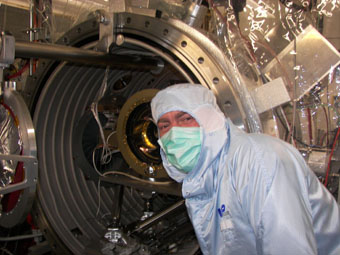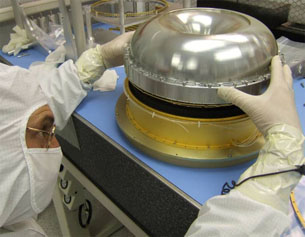Meet the IBEX Team: John Scherrer

Putting together a mission like IBEX is a lot like putting together a 1,000-piece puzzle -without the conceptual design on the box. Most of the people working on IBEX design or build just one small piece of the mission "puzzle", and they seldom have the chance to step back to view the big picture.
John Scherrer is one of the few people who concentrate on the mission as a whole. As project manager for the IBEX mission, John makes sure that all the IBEX pieces come together in the right way and at the right time to create a spacecraft, ground segment, and operations plan that is capable of successfully detecting the solar system's boundary on time and on budget.
It's a challenging job, but John loves getting to view the IBEX mission in its entirety. "I really like that I get to see the whole big picture of the IBEX mission. There are thousands of people working on IBEX, but they are focused on what their particular task or subsystem does. I get to look at IBEX from above and see the whole thing," John said.
When the inevitable glitch comes up, it's John's job to find a way to keep the schedule moving while the engineers find solutions. "I joke that sometimes my job feels like the whack-a-mole game," John said. "A little problem pops up, and I have to whack the mole." Due to the excellent work of the international team, the IBEX mission is making good progress. "We don't see any big issues out there for us. We're in really good shape," he said.
Right now, John is helping the different agencies that have been building separate pieces of IBEX to literally put them together. It is an international task that requires intense collaboration. For instance, the staff at Goddard Space Flight Center, in Maryland, recently completed assembling a component called the conversion surface assembly. They shipped it to Lockheed Martin in California, where technicians attached it to the assembly they built. They then shipped the completed subassembly to the University of Bern in Switzerland, where it will be connected to two subassemblies from the University of New Hampshire.
Getting the different parts of IBEX attached to each other, or integrated, is one of John's favorite parts of the job. "Where we're at in the program is really exciting in the sense that we're transitioning from everyone building their subsystems alone, to trying to integrate them to higher levels. When you get real hardware, and it's coming together and you can see that all the hard work has led up to this, it's worth it. I've been trying to get all the pieces to play nicely together. When you get them to the launch, that's the ultimate goal," John said.
As project manager, John flies all over the world to coordinate the efforts of all the agencies involved in getting IBEX built, off the ground, and into orbit. "Last year I had 25 trips, although most of them are just a couple days. Even though you have email and the telephone to communicate, you have to go to the different institutions to talk and see the hardware. There's nothing like face-to-face communications to keep things moving," John said.
Although he enjoys the productivity of face-to-face meetings, John finds getting to and from them less than pleasant. "[One of the worst parts of the job] is dealing with late airplanes," John said. He also finds it particularly difficult to fit his 6'5" frame into economy airplane seats. "Going to Switzerland is painful!" he said.
When he is at his office at the Southwest Research Institute in San Antonio, Texas, John spends most of his day communicating with IBEX collaborators. "I'm on the phone or in meetings for about six hours each day, and then I spend the other time doing emails. I'm mainly just trying to keep the plates spinning throughout the whole project - it's a ton of communication," John said.
As a boy growing up in San Antonio, John never imagined that engineering would require so many communication skills. "So much of what I have to do is communication, and in engineering school they don't push that as much as they should. You have to be a good writer, and you have to converse well. I didn't know that being a manager was such a big part of [engineering] back then. Dealing with people is a really big part of this job," John said.
John always wanted to be a mechanical engineer, and was drawn to building things and finding out how they worked. "I got in trouble for taking my father's washing machine motor apart because I wanted to build something with its copper wire. I also got in trouble for setting my carpet on fire in my bedroom with my chemistry set. I've always been interested in taking things apart and building stuff," he said.
When it came time to choose a college and career, John elected not to leave Texas. "I'm a San Antonio boy, and I loved San Antonio and wanted to stay here," he said. He completed a mechanical engineering degree from Texas A&M University. While he was there, John earned course credit and a salary as a coop student with Haliburton Services. He began working for them in 1982, but left for San Antonio and Southwest Research Institute (SwRI) when the oil industry declined.
When he began his job at SwRI, John worked in mechanical design. He soon discovered that he liked managing engineering projects even more than he liked being an engineer. "I liked the management side better than the engineering side, so I got my MBA [Master of Business Administration] while I was at SwRI, and climbed from managing little projects to bigger projects," John said.
He recommends that people wishing to break into the engineering field should do two things: "Do what you can to get experience in that field to start out. First, try doing a coop or an internship. Also, like I've been telling my daughter, who is a junior in high school, go up to a place you'd want to work and tell them you'll do it for free!"
In his free time, John enjoys bird hunting, fishing, playing volleyball, riding his bike, and attending his children's sporting events.
John hopes that he'll have the opportunity to continue looking at the big picture of NASA missions as his career progresses. "My ultimate goal is to keep managing bigger missions and to keep pushing it. I certainly don't see me sitting in a spacesuit somewhere, since I doubt that they have them in a size 44 XL!" he said.
